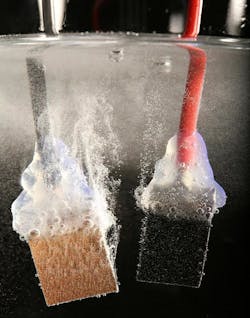Perovskite also converts solar energy to hydrogen fuel; what next?
Recently, Laser Focus World senior editor John Wallace blogged on the many emerging applications for the material perovskite (see http://www.laserfocusworld.com/articles/2014/08/make-all-your-photonics-from-perovskite.html); and now, a new application has been described in the journal Science by scientists in Michael Grätzel’s laboratory at École polytechnique fédérale de Lausanne (EPFL; Lausanne, Switzerland): producing hydrogen fuel from sunlight and water.
RELATED ARTICLE: Optofluidics assist solar fuel generation
By combining a pair of solar cells made with a mineral called perovskite and low cost electrodes, scientists have obtained a 12.3% conversion efficiency from solar energy to hydrogen, a record using earth-abundant materials as opposed to rare metals.
At the Laboratory of Photonics and Interfaces at EPFL, led by Michael Grätzel, where scientists invented dye solar cells that mimic photosynthesis in plants, they have also developed methods for generating fuels such as hydrogen through solar water splitting. To do this, they either use photoelectrochemical cells that directly split water into hydrogen and oxygen when exposed to sunlight, or they combine electricity-generating cells with an electrolyzer that separates the water molecules.
By using the latter technique, Grätzel's post-doctoral student Jingshan Luo and his colleagues were able to demonstrate a device that converts into hydrogen 12.3% of the energy diffused by the sun on perovskite absorbers—a compound that can be obtained in the laboratory from common materials, such as those used in conventional car batteries, eliminating the need for rare-earth metals in the production of usable hydrogen fuel.
This high-efficiency provides stiff competition for other techniques used to convert solar energy. But this method has several advantages over others. "Both the perovskite used in the cells and the nickel and iron catalysts making up the electrodes require resources that are abundant on Earth and that are also cheap,” explained Jingshan Luo. “However, our electrodes work just as well as the expensive platinum-based models customarily used."
"Once you have hydrogen, you store it in a bottle and you can do with it whatever you want to, whenever you want it," said Michael Grätzel. Such a gas can indeed be burned—in a boiler or engine—releasing only water vapor. It can also pass into a fuel cell to generate electricity on demand. And the 12.3% conversion efficiency achieved at EPFL "will soon get even higher," promised Grätzel.
These high-efficiency values are based on a characteristic of perovskite cells: their ability to generate an open-circuit voltage greater than 1 V (silicon cells stop at 0.7 V, for comparison). "A voltage of 1.7 V or more is required for water electrolysis to occur and to obtain exploitable gases," explained Jingshan Luo. To get these numbers, three or more silicon cells are needed, whereas just two perovskite cells are enough. As a result, there is more efficiency with respect to the surface of the light absorbers required. "This is the first time we have been able to get hydrogen through electrolysis with only two cells!" Luo adds. The team concludes that the combination of sun and water paves a promising and effervescent way for developing the energy of the future.
SOURCE: EPFL; http://actu.epfl.ch/news/cheap-hydrogen-fuel-from-the-sun-without-rare-meta/

Gail Overton | Senior Editor (2004-2020)
Gail has more than 30 years of engineering, marketing, product management, and editorial experience in the photonics and optical communications industry. Before joining the staff at Laser Focus World in 2004, she held many product management and product marketing roles in the fiber-optics industry, most notably at Hughes (El Segundo, CA), GTE Labs (Waltham, MA), Corning (Corning, NY), Photon Kinetics (Beaverton, OR), and Newport Corporation (Irvine, CA). During her marketing career, Gail published articles in WDM Solutions and Sensors magazine and traveled internationally to conduct product and sales training. Gail received her BS degree in physics, with an emphasis in optics, from San Diego State University in San Diego, CA in May 1986.
